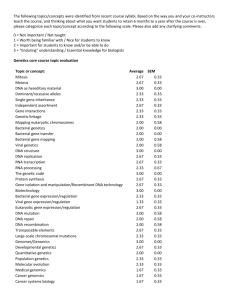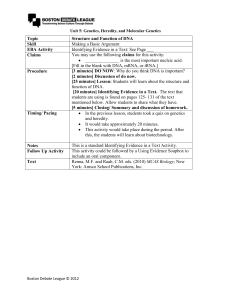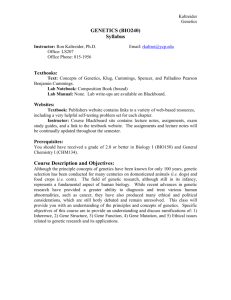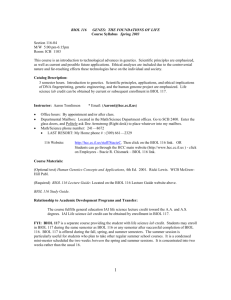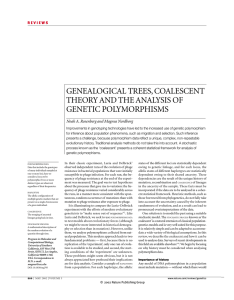Biol-419_08FL_Bin_Shuai
advertisement
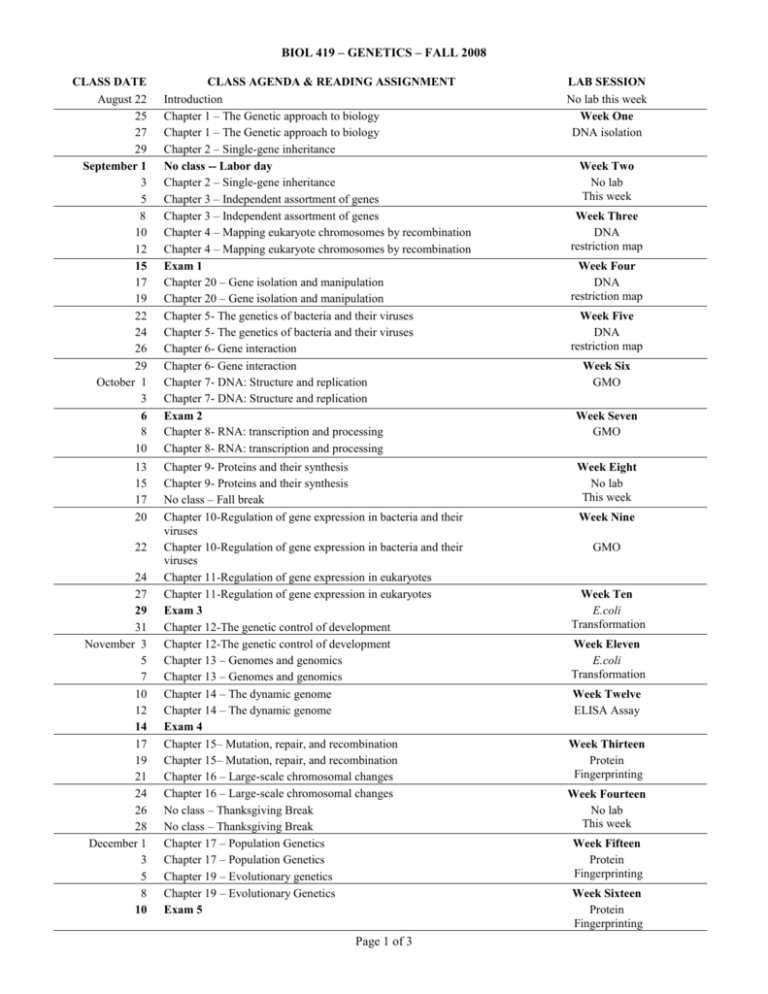
BIOL 419 – GENETICS – FALL 2008 CLASS DATE August 22 25 27 29 September 1 3 5 8 10 12 15 17 19 22 24 26 29 October 1 3 6 8 10 13 15 17 20 22 24 27 29 31 November 3 5 7 10 12 14 17 19 21 24 26 28 December 1 3 5 8 10 CLASS AGENDA & READING ASSIGNMENT Introduction Chapter 1 – The Genetic approach to biology Chapter 1 – The Genetic approach to biology Chapter 2 – Single-gene inheritance No class -- Labor day Chapter 2 – Single-gene inheritance Chapter 3 – Independent assortment of genes Chapter 3 – Independent assortment of genes Chapter 4 – Mapping eukaryote chromosomes by recombination Chapter 4 – Mapping eukaryote chromosomes by recombination Exam 1 Chapter 20 – Gene isolation and manipulation Chapter 20 – Gene isolation and manipulation Chapter 5- The genetics of bacteria and their viruses Chapter 5- The genetics of bacteria and their viruses Chapter 6- Gene interaction Chapter 6- Gene interaction Chapter 7- DNA: Structure and replication Chapter 7- DNA: Structure and replication Exam 2 Chapter 8- RNA: transcription and processing Chapter 8- RNA: transcription and processing Chapter 9- Proteins and their synthesis Chapter 9- Proteins and their synthesis No class – Fall break Chapter 10-Regulation of gene expression in bacteria and their viruses Chapter 10-Regulation of gene expression in bacteria and their viruses Chapter 11-Regulation of gene expression in eukaryotes Chapter 11-Regulation of gene expression in eukaryotes Exam 3 Chapter 12-The genetic control of development Chapter 12-The genetic control of development Chapter 13 – Genomes and genomics Chapter 13 – Genomes and genomics Chapter 14 – The dynamic genome Chapter 14 – The dynamic genome Exam 4 Chapter 15– Mutation, repair, and recombination Chapter 15– Mutation, repair, and recombination Chapter 16 – Large-scale chromosomal changes Chapter 16 – Large-scale chromosomal changes No class – Thanksgiving Break No class – Thanksgiving Break Chapter 17 – Population Genetics Chapter 17 – Population Genetics Chapter 19 – Evolutionary genetics Chapter 19 – Evolutionary Genetics Exam 5 Page 1 of 3 LAB SESSION No lab this week Week One DNA isolation Week Two No lab This week Week Three DNA restriction map Week Four DNA restriction map Week Five DNA restriction map Week Six GMO Week Seven GMO Week Eight No lab This week Week Nine GMO Week Ten E.coli Transformation Week Eleven E.coli Transformation Week Twelve ELISA Assay Week Thirteen Protein Fingerprinting Week Fourteen No lab This week Week Fifteen Protein Fingerprinting Week Sixteen Protein Fingerprinting BIOL 419 – GENETICS – FALL 2008 INSTRUCTOR Dr. Bin Shuai Department of Biological Sciences Office: Hubbard Hall Room 418 Phone: 978-6142 Email: bin.shuai@wichita.edu Office hour: MW 10:00 am – 11:00 am GRADUATE TEACHING ASSISTANTS Megan Simpson Ramesh Padmanabhan TEXTBOOK Introduction to Genetic Analysis 9th Edition by Griffiths et.al. ISBN: 0-7167-6887-9 Publisher: W.H. Freeman PREREQUISITES In order to take this course, you should already have completed Biol 210 – General Biology I, Biol 211 – General Biology II and Chem 112 – General and Inorganic Chemistry. EXAMINATIONS AND GRADING All class examinations will be given during normal classroom hours on the date indicated on the class schedule. There is no make up exam. Grade-earning activities include lecture exams, class participation, and lab quizzes. The overall course grade will be determined from the total points (720 points) obtained from the five class examinations (maximum of 500 points at 100 points per exam), in-class participation (maximum of 100 points), and the lab grade (maximum of 120 points). The overall lab grade will be based on performance in weekly quizzes. All lecture examinations will cover the material presented since the previous examination. CLASS AND LABORATORY ATTENDANCE Your attendance at each class and laboratory session is required. For the class session of the course, you will sign in for each attendance. Three absences of lecture and one absence of lab will be excused. After that, each absence will result in the reduction of the final course grade by ½ of a letter grade. The same policy applies for the laboratory session. In-class participation Each chapter will be covered in two class periods, with the first lecture given by the instructor followed by an interactive group exercise in the second lecture. The class will be divided into 7 groups which will be determined during the first week of the class. After the first lecture for each chapter, each group will be given a question. The group members will work together to solve the problem, and present the solution during the class period for group exercises. Rules for group exercises: Each group should have at least 8 students, and can’t have more than 12 students; Each student has the option to sign up into a particular group before Aug 26, 2008, the rest will be assigned randomly into existing groups by the instructor; (The sign up sheets will be posted outside my office at HH418); Page 2 of 3 BIOL 419 – GENETICS – FALL 2008 The group members should decide your meeting time and the group policies to make sure that everyone is making a good effort in solving the problems. I will give group members the right to vote out the student(s) who is/are not contributing to the group; All questions will be posted on Blackboard in advance, each group will be randomly assigned one question; The group should decide who will be presenting the answer. The presenter has to show the rest of the class how to work out the solution using appropriate visual aids (for example, draw on the board, or use transparency etc.). The presenter and the rest of the group should address any questions raised by the class and the instructor. Reward: In each lecture period, the group that provides correct answer clearly will be given 10 points. Partial credit will be considered for incomplete answers. The maximum bonus points for each group are limited to 100 points during the semester. The instructor will award the best presenter in each class period with 5 additional bonus points. The total bonus points for each student are limited to 20 (the bonus points are additional, not part of the 720 total points for the class). POLICY ON LABORATORY VOUCHER RECEIPTS A receipt for a non-refundable laboratory voucher, which you must purchase at the RSC Bookstore, is required to complete your enrollment in this course. The receipt must be presented to your laboratory instructor, no later than the second laboratory meeting, in order to continue your enrollment in this course. POLICY ON ACADEMIC HONESTY The Department of Biological Sciences adheres to the University Policy on Academic Honesty as described in the Undergraduate Catalog, the Graduate Bulletin and the Student Handbook. The penalties for breach of this policy vary with the degree of dishonesty and will be determined by the faculty member teaching the course. Such penalties may range from reprimand to dismissal from the University. Typical first offense penalties include, but are not limited to, receiving a zero on an examination for cheating; receiving zero points for the laboratory portion of the course for cheating on a laboratory examination (if there is a lab associated with the course); or, receiving a letter grade of “F” in the course for plagiarizing material. Penalties may be more severe in cases of repeat offenses. In all cases, a report of the violation will be placed in the student’s permanent file in the Dean’s office of the student’s College. Students may appeal all disciplinary actions for violations of the Policy by following the procedures of the Court of Student Academic Appeals. SUGGESTED STUDY PLAN FOR THE CLASS COMPONENT Before attending class, read the chapter in your textbook that will be covered in the class. Make sure you understand the self study materials. Attend the class; take notes about the topics covered by the instructor. After class, return to the notes and ensure that you understand the concepts covered in class. Evaluate yourselves using problems at the end of each chapter. If you are having difficulty mastering the concepts covered, try gaining further understanding from the following sources: o Return to the text and review the concepts o Make an appointment with the instructor and come prepared to ask specific questions o Form a study group early in the semester that meets regularly during the semester Page 3 of 3

